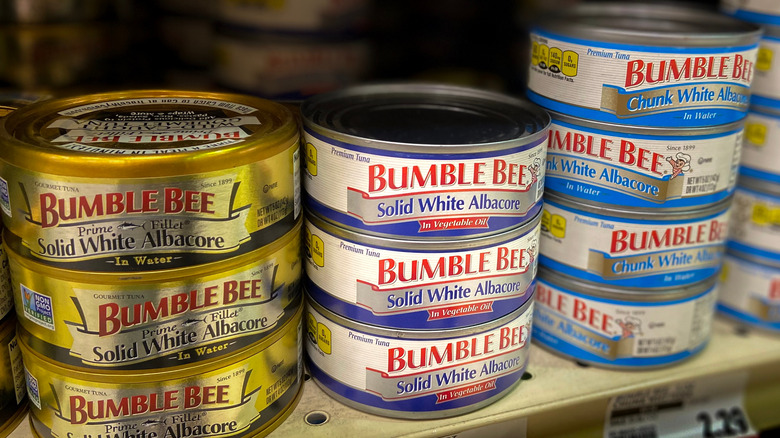The Economical Origin Of The Canned Tuna Industry
Canned tuna once held the title of America's most popular seafood. According to data cited by The Washington Post, tuna held that title for 50 years (1950 to 2000). During that half-century, more than 85% of American households had tuna fish stocked away in their pantry. Not bad for a business that, at the time, was only just turning 50 itself.
That popularity has not lasted into this century. Again citing The Washington Post, canned tuna sales have been declining steadily since 2000. Numerous reasons, not the least of which are concerns over mercury levels and oceanic sustainability, have led to this decline. Grandview Research, however, predicts a global market growth rate of 4.7% between 2020 and 2027, with revenues rising from $8.57 billion to $11.89 billion.
So it's not as though canned tuna is going anywhere. In spite of industry ups and downs, American grocery shelves will never again be without Chicken of the Sea, StarKist, and Bumblebee. Indeed, the economic origins of canned tuna share the ups and downs of modern economics, and it's actually thanks to another once popular fish that canned tuna exists at all.
From east coast sardines to west coast tuna
You cannot talk about the history of canned tuna without talking about sardines. According to Zingerman's Delicatessen, the humble sardine was once the canned fish of choice for the American people. The New England state of Maine was a leader in canned sardines — at the turn of the 20th century, virtually all sardines sold in the U.S. had been caught and canned in Maine (via the Portland Press Herald).
On the West Coast, things were not so prosperous. As Canned-Tuna.com tells us, the southern California sardine catch of 1903 was exceptionally poor. It was during this time that an intrepid canner named Albert P. Halfhil began using his empty sardine cans to experiment with packing another fish: local albacore. In spite of a modest start — only 700 cases sold in the first year — Halfhil was selling over 400,000 cases by 1914. Other companies, such as the Columbia River Packers Association (now The Bumblebee Seafood Company), seeing the upwards sales trends and abundance of migratory albacore, began building canneries along the coasts of Oregon and Alaska. By 1954, after two world wars and exceptional technological/population growth, the U.S. was the world's largest producer and consumer of canned tuna.
Though things have changed drastically for the tuna industry over the years, there is no denying that it still serves as a great American seafood institution. One that is willing and ready to adapt, as Bumblebee is doing, to a changing market for a changing world.

